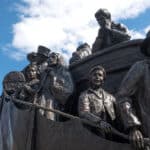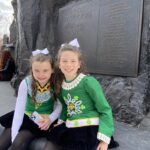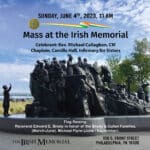The Irish Memorial
Front and Chestnut Streets
The Irish Memorial to “An Gorta Mór” Irish for “the great hunger”, was designed by celebrated bronze artist Glenna Goodacre, who is responsible for the Vietnam Women’s Memorial on the Mall in Washington, DC.
Approximately 12 feet high, 30 feet long, and 12 feet wide, The Memorial contains 35 figures arranged in vignettes representing the despair and hope of the Irish immigrant’s story. On the east end and lowest point of the monument, an anguished woman clutches her rag-swaddled child while another digs for potatoes in the shadow of Celtic crosses marking graves as a distressed young boy looks on. At its highest point, it depicts the arrival of the forward-looking emigres at the docks in America where they will start a new and better life, greeted by a waving figure on the ground that speaks of hope and promise.
Eight memorial plinths line the walkways of The Memorial. A plaque on each describes a different aspect of the great hunger, from the events leading up to the potato blight that led to An Gorta Mor, the deaths of a million Irish people and the emigration of more than 1 million more. Each of the paths are oriented to highlight the principal themes of the sculpture.
Statue of Commodore John Barry
Independence Square, south side of Independence Hall.
Born in County Wexford, Ireland, Barry started as a cabin boy on his uncle’s fishing skiff. He made his way as a young man to Philadelphia, both for the religious freedom of the colonies (Barry was Catholic) and for the city’s maritime opportunities. He honed his skills carrying cargo between Philadelphia and the West Indies. With the beginning of hostilities between America and Great Britain, Barry was given the task of outfitting the first Continental Navy ships which set sail from Philadelphia. He was the first to capture a British ship. But one of the most daring of all his wartime exploits—and there were many–came in 1778 when he commanded a flotilla of rowboats, longboats, barges, and other small craft and destroyed three British ships, holding a frigate and ship-of-the-line at bay and gathering valuable intelligence. Though he returned to maritime trade at the end of the war, he was selected senior Captain of the Federal Navy by President George Washington, earning him the title “Father of the Navy of the United States,” which is engraved on this bronze statue, by Samuel Murray, erected in 1908 by the Philadelphia-based Friendly Sons of St. Patrick.
Old St. Mary’s Church
252 S 4th St
The second oldest Roman Catholic institution in Philadelphia, built in 1763, is the final resting place of several Irish notables, including John Barry, father of the American Navy; Matthew Carey, who was one of the most important publishers in early America; Thomas Fitzsimons, a signer of the Constitution and a member of the Continental Congress, and the first, second, and third Congress; John Neagle, a foremost portrait painter in the early days of America; Stephen Moylan, George Washington’s aide-de-camp; and George Meade, grandfather of General George Meade, the hero of Gettysburg, who himself raised money to fund privateers in the Revolutionary War and to feed Washington’s troops at Valley Forge.
But it was also a hub for America’s revolutionaries. The Continental Congress met there four times. On July 4, 1779, the first public religious commemoration of the Declaration of Independence was held at St. Mary’s. Though not parishoners, George Washington and John Adams both worshipped there. In early church history French, Spanish, and Portuguese ambassadors to the new country had special pews set aside for them.
The crucifix in the church was carved by Philadelphia sculptor William Rush, who is considered America’s first major sculptor. He got his start carving ship’s figureheads in wood and was in great demand when the nascent US Navy began building ships in the city. He was one of the founders of the Pennsylvania Academy of Fine Arts. His ship figurehead, Peace, at the Independence Seaport Museum is one of a number of his works exhibited around the city. A life-sized statue of George Washington is at the Second Bank of the United States at 4th and Chestnut Streets.
American architect Thomas Ustick Walter, who designed the US Capitol, crafted the front of the church organ.
Across the street from Old St. Mary’s is Old St. Joseph’s, the oldest Roman Catholic parish in the city, founded by English Jesuits in 1733. John Barry married his first wife there in 1767. The current church was finished in 1839. In 1848, the parish was the birthplace of the St. Joseph Society for the Relief of Irish Immigrants, an organization spurred by the influx of Irish immigrants at the nearby docks.
Olde St. Augustine’s Church
243 N. Lawrence Street
The cornerstone for the original church was laid in 1796 at the behest of two Irish friars who were sent by the Vatican to buy the land, oversee the building, and minister to the area’s growing Irish population. George Washington, John Barry, and Thomas Fitzsimmons all contributed to the church fund and local architect, Nicholas FitzMaurice Fagan designed the building. At one time, it had the largest theological library in the city, but it was burned during the Nativist Riots of 1844, an anti-immigrant, anti-Catholic movement fueled by xenophobia, its tinder Philadelphia’s large Irish population (second largest in the country).
When nativist groups attempted to meet in Kensington, a predominantly Irish neighborhood then north of the Philadelphia city border, fighting broke out which led to the burning of St. Michael’s Church, 1437 N. Second Street. The throng marched to and surrounded St. Augustine’s which was set on fire. It was rebuilt in 1848.
The events led to laws requiring each major district in Philadelphia to provide financial support for one police officer for each 150 taxable inhabitants and in 1850, a new Philadelphia Police District was created to cover the entire urban area, including then outlying districts Kensington and Southwark, where rioting had also occurred around St. Philip Neri Church, 218 Queen Street.
St. Augustine’s is also known for the “sister bell” of the Liberty Bell, which once hung in its steeple, and the St. Augustine Academy for Boys, founded in 1811, which later became Villanova University, which is still operated by the Augustinian Friars. More recently, it was seen in the M. Night Shamalyan movie, The Sixth Sense. It’s the place where the characters played by Bruce Willis and Haley Joel Osment meet for the first time.
The Rosenbach Museum
2008 Delancey Place
https://www.rosenbach.org
On one of the museum’s “Hands-on Tours,” you can touch and even turn a page of a handwritten copy of James Joyce’s Ulysses or the notes and outlines for Bram Stoker’s “Dracula,” two of the most important pieces of literature of Irish and English interest in the museum’s collection which also includes works by Dylan Thomas, Lewis Carroll (Charles Dodgson), William Blake and Charles Dickens. The Rosenbach also houses the works and papers of poet Marianne Moore and recently acquired a rare first edition of Mary Shelley’s Frankenstein, a copy of Two World Monthly, which serialized Ulysses without Joyce’s permission, and The Vampyre, the first English vampire story which was written by Lord Byron’s personal physician, John Polidori.
The Commodore John Barry Club (The Irish Center)
6815 Emlen Street
https://theirishcenter.com
In a 111-year-old building that once housed an automobile club complete with bowling alley, The Commodore Barry Club—known as The Irish Center—is the meeting place for the county societies, the headquarters and performance space for the Philadelphia Ceili Group, and host to the still elegant county balls, the Miss Mayo and Mary from Dungloe Pageants and other events. The Emerald Society Pipes and Drums practices its marching tunes in the ballroom and the Cummins School of Irish Dance offers weekly lessons in Irish step dancing. Every week, there are lessons in set and ceili dancing, music, and Irish language, as well as regular ceilis, music sessions, singers’ sessions, and Gaelic sports broadcasts (often over a full Irish breakfast in the bar).
St. Malachy’s Church
1429 North 11th Street
http://saintmalachyparish.com
Called “a famine church”, St. Malachy’s Irish beginnings can be seen in the shamrocks on the altar, the tile work based on the Book of Kells, and magnificent stained glass window of St. Patrick, his feet in a cloud of green shamrocks. The church, founded in 1850, was built largely by Irish immigrants when Bishop Francis Patrick Kenrick, born in Dublin, was the third bishop of Philadelphia. The parish school, founded in 1860 by Father John Kelly, was staffed by Irish nuns of the order of the Sisters of Mercy. Bishop Kenrick endeared himself to the people of Philadelphia shortly after his arrival in the city when a cholera epidemic broke out and he opened up the residence of St. Augustine’s for use as a hospital, brought in the Daughters of Charity and encouraged parish priests to care for the ill.
It was during Bishop Kenrick’s watch that the anti-Catholic nativist riots took place, sparked in part by his comments about Catholic students being forced to take part in Protestant services— specifically, readings from the King James version of the Bible—in the public schools. However, he may have saved lives during this short-lived insurgency by ordering churches to close their doors and for services to be suspended.
The unassuming church building in North Philadelphia hides a breathtaking masterpiece of Byzantine architecture inside, designed in 1900 by well known Philadelphia architect Henry D. Dagit.Mass is said daily and once on Sunday.
Plaque Honoring the Irish Patriots of the Revolutionary War
Dilworth Plaza, the west side of City Hall
In 1926, The Friendly Sons of St. Patrick, the oldest Irish organization in the US that welcomed Irish of every religion since its founding, installed a plaque at Philadelphia’s City Hall honoring the Irish who served in the Revolutionary War. They include several signers of the Declaration of Independence, as well as Commodore John Barry, father of the American Navy, and Captain Jeremiah O’ Brien, the son of a Dublin tailor who gained America’s first naval victory of the war for independence.






